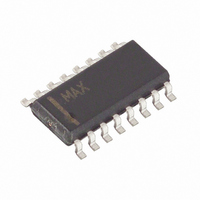MAX4511ESE+ Maxim Integrated Products, MAX4511ESE+ Datasheet - Page 10

MAX4511ESE+
Manufacturer Part Number
MAX4511ESE+
Description
IC SWITCH QUAD SPST 16SOIC
Manufacturer
Maxim Integrated Products
Datasheet
1.MAX4512ESE.pdf
(17 pages)
Specifications of MAX4511ESE+
Function
Switch
Circuit
4 x SPST - NC
On-state Resistance
160 Ohm
Voltage Supply Source
Single, Dual Supply
Voltage - Supply, Single/dual (±)
9 V ~ 36 V, ±4.5 V ~ 18 V
Operating Temperature
-40°C ~ 85°C
Mounting Type
Surface Mount
Package / Case
16-SOIC (0.154", 3.90mm Width)
Number Of Switches
Quad
Switch Configuration
SPST
On Resistance (max)
200 Ohms
On Time (max)
600 ns
Off Time (max)
500 ns
Off Isolation (typ)
- 62 dB
Supply Voltage (max)
+/- 18 V
Supply Voltage (min)
+/- 4.5 V
Maximum Power Dissipation
842 mW
Maximum Operating Temperature
+ 85 C
Mounting Style
Through Hole
Description/function
Analog Switch
Input Level
CMOS, TTL
Minimum Operating Temperature
- 40 C
Off State Leakage Current (max)
10 nA
Lead Free Status / RoHS Status
Lead free / RoHS Compliant
Quad, Rail-to-Rail, Fault-Protected,
SPST Analog Switches
(NO) switch is shown; the normally closed (NC) config-
uration is identical except the logic-level translator
becomes an inverter. The analog switch is formed by
the parallel combination of N-channel FET N1 and P-
channel FET P1, which are driven on and off simultane-
ously according to the input fault condition and the
logic-level state.
Two comparators continuously compare the voltage on
the NO_ (or NC_) pin with V+ and V-. When the signal
on NO_ or NC_ is between V+ and V- the switch acts
normally, with FETs N1 and P1 turning on and off in
response to IN_ signals. The parallel combination of
N1 and P1 forms a low-value resistor between NO_ (or
NC_) and COM_ so that signals pass equally well in
either direction.
When the signal on NO_ (or NC_) exceeds V+ by about
50mV, the high-fault comparator output is high, turning
off FETs N1 and P1. This makes the NO_ (or NC_) pin
high impedance regardless of the switch state. If the
switch state is “off”, all FETs are turned off and both
NO_ (or NC_) and COM_ are high impedance. If the
switch state is “on”, FET P2 is turned on, sourcing cur-
rent from V+ to COM_.
When the signal on NO_ (or NC_) exceeds V- by about
50mV, the low-fault comparator output is high, turning
off FETs N1 and P1. This makes the NO_ (or NC_) pin
high impedance regardless of the switch state. If the
switch state is “off,” all FETs are turned off and both
NO_ (or NC_) and COM_ are high impedance. If the
switch state is “on,” FET N2 is turned on, sinking cur-
rent from COM_ to V-.
When a fast rise-time and fall-time transient on IN_
exceeds V+ or V-, the output (COM_) follows the input
(IN_) to the supply rail with only a few nanoseconds
delay. This delay is due to the switch on-resistance and
circuit capacitance to ground. When the input transient
returns to within the supply rails, however, there is a
longer output recovery time delay. For positive faults, the
recovery time is typically 3.5µs. For negative faults, the
recovery time is typically 1.3µs. These values depend on
the COM_ output resistance and capacitance, and are
not production tested or guaranteed. The delays are not
dependent on the fault amplitude. Higher COM_ output
resistance and capacitance increase recovery times.
10
Transient Fault Response and Recovery
______________________________________________________________________________________
Negative Fault Condition
Positive Fault Condition
Normal Operation
FETs N2 and P2 can source about ±10mA from V+ or V-
to the COM_ pin in the fault condition. Ensure that if the
COM_ pin is connected to a low-resistance load, the
absolute maximum current rating of 30mA is never
exceeded, both in normal and fault conditions.
The GND, COM_, and IN_ pins do not have fault protec-
tion. Reverse ESD-protection diodes are internally con-
nected between GND, COM_, IN_ and both V+ and V-. If
a signal on GND, COM_, or IN_ exceeds V+ or V- by
more than 300mV, one of these diodes will conduct
heavily. During normal operation these reverse-biased
ESD diodes leak a few nanoamps of current to V+ and V-.
The maximum fault voltage on the NC_ or NO_ pins is
±36V with power applied and ±40V with power off.
The MAX4511/MAX4512/MAX4513 are not lightning
arrestors or surge protectors.
Exceeding the fault-protection voltage limits on NO_ or
NC_, even for very short periods, can cause the device
to fail. The failure modes may not be obvious, and fail-
ure in one switch may or may not affect other switches
in the same package.
There is no connection between the analog signal
paths and GND. The analog signal paths consist of an
N-channel and P-channel MOSFET with their sources
and drains paralleled and their gates driven out of
phase to V+ and V- by the logic-level translators.
V+ and GND power the internal logic and logic-level
translators and set the input logic thresholds. The logic-
level translators convert the logic levels to switched V+
and V- signals to drive the gates of the analog switch-
es. This drive signal is the only connection between the
power supplies and the analog signals. GND, IN_, and
COM_ have ESD-protection diodes to V+ and V-.
The logic-level thresholds are CMOS and TTL compati-
ble when V+ is +15V. As V+ is raised the threshold
increases slightly, and when V+ reaches 25V the level
threshold is about 2.8V—above the TTL output high
level minimum of 2.4V, but still compatible with CMOS
outputs (see Typical Operating Characteristics).
Increasing V- has no effect on the logic-level thresholds,
but it does increase the gate-drive voltage to the signal
FETs, reducing their on-resistance.
Fault-Protection Voltage and Power Off
IN_ Logic-Level Thresholds
COM_ and IN_ Pins
Failure Modes
Ground











